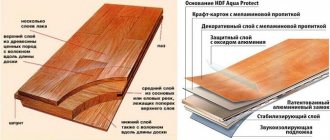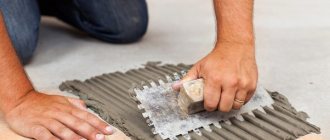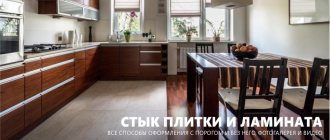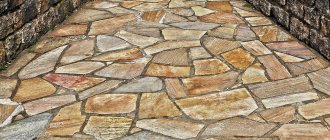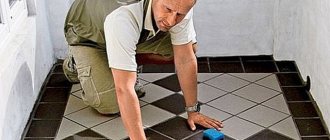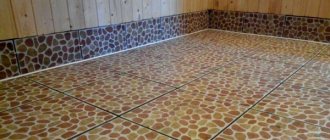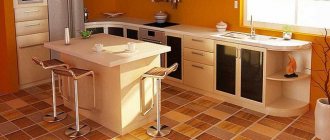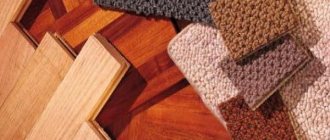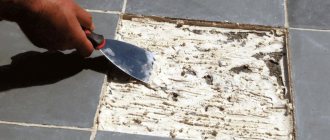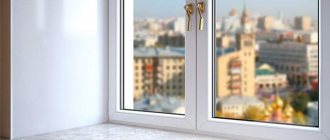Which is better - laminate or tile , and why quartz vinyl is the ideal option
? Repair work in your favorite apartment is a responsible and rather difficult undertaking, especially when it comes to choosing flooring for the kitchen. The fact is that everything in this room should be easy to use, beautiful, durable and easy to clean. It is for this reason that people more often began to think about what is better for the kitchen - laminate or tile.
We propose to talk about the intricacies of each type of coating, as well as the difference between porcelain stoneware and tiles, and we will tell you about everything further in order.
What should the floor be like in the kitchen?
Before you buy a certain type of coating, you should study in detail the requirements for the use of the floor in certain rooms.
- Increased humidity levels. A constant factor for every kitchen where food is regularly prepared, and this includes steam in the room settling on the floor, the need to thoroughly clean and dry surfaces. Also, when washing dishes, droplets may fly away. Liquid spills, leaks, etc. often occur.
- Intense pollution. When preparing food, pieces of food fall on the floor, loose substances spill out, and drops of fat and liquids fall on the floor. All this needs to be washed in a timely manner. Therefore, caring for the coating should be as simple as possible.
- High cross-country ability. This is especially true for a kitchen combined with a dining room. Family members simultaneously or alternately heat food, prepare food and drinks, and constantly go to the refrigerator for snacks. The kitchen is perhaps the most visited room in the house.
- Temperature changes. Cooking, airing, evaporation, burning of food, operation of the hood and air conditioner - all this is accompanied by frequent and sudden changes in temperature in the room.
Quartz vinyl
Quartz vinyl is, in fact, an analogue of laminate, which also has a locking fastening, and is made on the basis of quartz sand flour, bonded with polyvinyl chloride. In Europe and the USA, the designation LVT (Luxury Vinyl Tile) is accepted - luxury vinyl tiles.
The material itself is elastic. And many who encounter it for the first time say: “Well, this is linoleum!” Here it is necessary to clarify: the linoleum we are used to consists of a mesh on which foamed polyvinyl chloride is applied and a picture is printed on top.
It is distinguished from quartz vinyl by the absence of a base load-bearing layer of quartz sand, which gives LVT very high resistance to crushing (1500 kg), very high heat capacity of the material, and very high noise insulation.
pros
Minuses
Are there broken and unused tiles left after renovation? Editorial “So Simple!” offers 14 ideas for using leftover ceramic tiles and mosaics. Who would have thought that so many interesting things could be made from construction waste!
New Year is always an expectation of something especially bright and joyful, an anticipation of not only a holiday, a feast, but also some changes, preferably for the better.
It is on the eve of the New Year that most often there is a desire to update something in the apartment. We have prepared 11 spectacular ideas for readers on how to update the design of an apartment before the holiday without significant financial costs.
Source
Floor covering requirements
In order for the floor to last a long time, not lose the presentability of its original appearance, and be fairly easy to maintain, it must meet certain requirements for the material:
- Moisture resistance. Taking this factor into account, you should choose a coating that can be used in conditions of high humidity levels in the room, so that it can be easily maintained without fear of preserving the appearance.
- Thermal conductivity. The materials used must have heat retention properties so that your feet do not freeze and it is comfortable to move on the floor.
- Soundproofing. This factor should also be taken into account, since the kitchen may contain household appliances (washing or dishwasher, refrigerator, etc.), sometimes while cooking you can drop pots and hear noise complaints from neighbors.
- Hardness. The floor covering should not be too hard. It is good when the coating is a little pliable so that cracks do not form on it and reduce the likelihood of the dishes breaking.
- Ease of care. Choose types of materials that are easy to clean without the use of expensive stain removers and special cleaning agents, which sometimes have a persistent chemical odor.
Laminate or tile best meet these requirements. All that remains is to compare their advantages and disadvantages.
A little about quartzvinyl
Quartz vinyl is a material that combines the properties of both laminate and tile. This material has advantages, and most often you can only find positive reviews about it.
Advantages:
- Quartz vinyl tiles are stronger than linoleum and resistant to mechanical damage.
- It is possible to restore the coating without replacing the entire floor; individual tiles can be removed and replaced with a new one.
- Quartz vinyl tiles have excellent thermal conductivity, are pleasant to the touch, and pleasant to walk on.
- When heated to +60 degrees, the material does not emit harmful substances and does not harm the human body.
- Does not change color when exposed to sunlight.
- Contains no phenol or melamine.
- Operating temperature from -30 to +60 degrees.
- The top part of the coating is anti-slip.
- Excellent frost-resistant characteristics.
- Excellent fire protection characteristics. Excellent sound absorption and sound insulation.
- Lots of styling options.
- The coating is resistant to all detergents and abrasives.
- Service life is about 30 years.
As you can see, this material is the best, however, its cost is much higher.
Laminate in the kitchen
A popular coating made in several layers with a protective film on the surface. A floor made from this material several years ago was considered an elite type, but today its cost has dropped, it has become more accessible, while the quality characteristics have been preserved.
It is also valued for its appearance, as it can imitate valuable wood species, other natural materials, marble, tiles, etc. It is almost impossible to visually distinguish what material the floor is made of.
Advantages of laminate
- Practicality. The material is easy to maintain; stubborn and difficult to remove stains can be easily removed with a simple soap solution. In particularly difficult cases, special stain removers can be used without causing damage to the coating.
- Good sound insulation. This is facilitated by several layers of material that absorbs noise from fallen objects.
- Thermal conductivity. This property increases the comfort of using a material on which you can safely walk barefoot, without additional heated floor equipment. Retains heat for a long time.
- Moisture resistance. The protective film on the surface protects the material from damage caused by excessive moisture.
- Resistance to deformation. Retains its shape and technical characteristics even with sudden changes in temperature.
- UV resistance. Laminate flooring can be safely laid on the sunny side - the material does not fade and is not subject to deformation from direct exposure to ultraviolet radiation.
- Wear resistance. Depends on the class of material. With the right choice, operation for a long time is possible without loss of properties, technical characteristics and presentable appearance.
The weak points of the laminate should also be taken into account:
- Susceptibility to mechanical damage. With intensive use with regular impacts, damage to the coating by sharp and piercing objects, the appearance loses its attractiveness, and the positive characteristics of the material may be lost.
- The weak points of the product are the joints of the lamellas and their end parts. You should periodically check the tightness of the panels. If moisture gets into the joints, the floor may swell and swell, which will require replacing it completely or partially.
Laminate flooring is perfect for those tidy owners who take care of plumbing and household appliances, prevent water leaks, and ensure the safety of the floor covering.
Conclusion
In the video presented in this article you will find additional information on this topic. Also, based on the text presented above, we can conclude that both materials under consideration are excellent for creating a topcoat in the living room. However, the cost of porcelain stoneware is quite high, and using it for these purposes is very wasteful and impractical.
At the same time, the ease of installation of laminate makes it a leader in flooring for interior use in places with low humidity. It has sufficient characteristics and fully satisfies the requirements for the surface of residential premises. At the same time, porcelain tiles are perfect for the bathroom or kitchen.
Kitchen floor tiles
Ceramic or vinyl tiles have found their use not only on floors, but are also used to protect walls in the kitchen and bathroom.
Pros of tiles
- Duration of service life. Such a significant advantage is possible with proper installation of the finishing material and careful treatment of it. The service life is several decades.
- High wear resistance. The material does not depend on the traffic of the room; the appearance of the products is preserved for a long time without significant damage.
- Moisture resistant. This finishing material is completely resistant to water spills; this is its main difference from laminate.
- Chemical resistance. The tile is impervious to household chemicals and special stain removers - dirt is removed, and the surface of the product remains unchanged, without damage or deformation.
- Preservation of color. The design on ceramic tiles does not wear off or fade for a long period of time. The pattern on vinyl tiles is artificial; the image may fade and fade if exposed to direct sunlight for a long time.
- Soundproofing. Vinyl coating absorbs noise well. Ceramic does not have such properties.
Cons of tiles
- Lack of sound insulation. When hitting a tile, household items break, frozen food becomes deformed, and the sound of the impact is heard far beyond the premises.
- Slip. You should be careful when handling wet tiles, as walking on them is quite dangerous and can cause injury. Monitor the humidity level and wipe the floor dry.
- Poor thermal conductivity. Tile is perhaps the coolest type of flooring. To eliminate this drawback, you should additionally install a warm floor or lay down rugs.
- Hard surface. When hitting a tile, glass products and other objects made of fragile materials break and crack.
- The tiles should be laid without allowing voids underneath, and without skimping on mortar, otherwise there is a high probability of premature deformation of the products.
When comparing floor coverings, it should be borne in mind that laying laminate flooring is much easier and faster; no special skills are required. You can practice assembling and disassembling the boards without damaging them.
Laying tiles requires experience and skills in construction and finishing work. You need to be able to dilute the solution, maintain a horizontal surface and other conditions, otherwise the coating will swell or chip.
Not only the comfort of moving on the floor, but also the overall impression of the house and its owners depends on how correctly the type of covering material is chosen, how correctly and accurately it is laid.
Recommendations from professionals
Even real finishing professionals cannot unanimously say whether tiles or laminate will be the best option for laying the floor in the kitchen.
According to them, the final choice will be influenced by several factors:
- Budget.
- Personal preferences.
- Presence/absence of heated floor in the room.
- Patency.
- Intensity and frequency of use of the premises.
High-quality tile flooring, be it ceramic or vinyl, will be much more expensive than laminate. If the kitchen space will be used every day, but not for several hours at a time, and there are also a couple of people living in the house, then even laminate flooring would be an ideal covering. If the kitchen is used every day and for a long time, then the best solution would be tiles. When choosing, be sure to take into account the heating intensity of the room.
Please note that if the kitchen is cool, then tiles on the floor will not be the best option. In addition, with such a coating it is almost impossible to make the room cozy, and for lovers of minimalism this is the ideal solution.
If you decide to make a choice in favor of tiles, then it should be:
Plain or with a simple pattern.- High quality.
- No cracks or chips.
- It is best if it has an additional anti-slip coating.
Additional comfort can be created by either a heated floor system or small rugs (the main thing is that the pile is short) on the floor surface. If you decide on laminate, then you should choose lamellas with the maximum class of resistance to moisture and wear. Before purchasing, you should familiarize yourself with the manufacturer’s recommendations on the use of detergents and the degree of protection from ultraviolet rays. Most experts advise choosing not just one coating, but combining both. To do this, you will need special aluminum fittings, which can make the joints between the slats and the tiles almost invisible.
In this case, the tiles need to be laid near the work area - cutting table, sink and stove, and the rest of the space can be covered with laminate. In any case, the choice of a specific floor covering depends on your budget and preferences.
